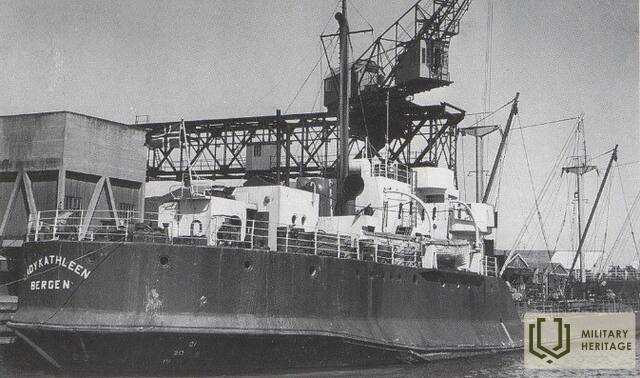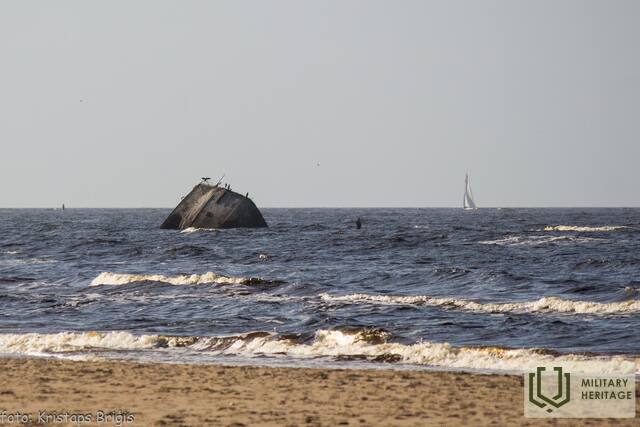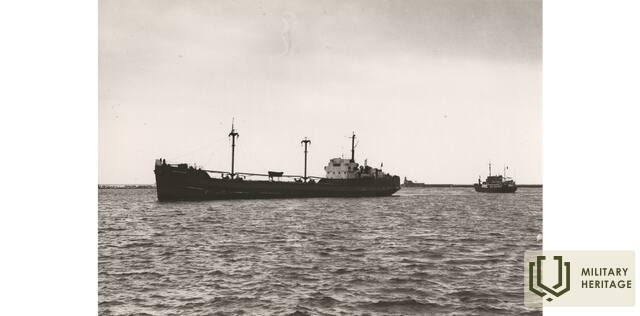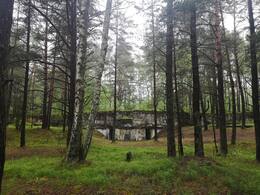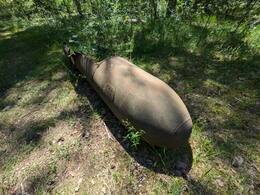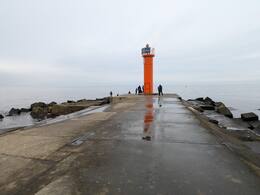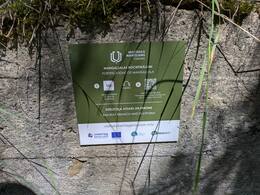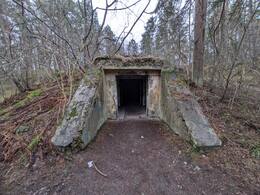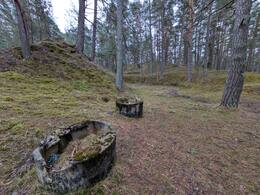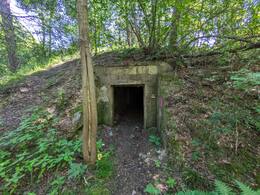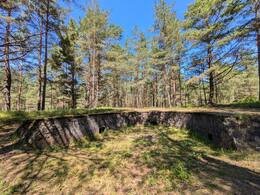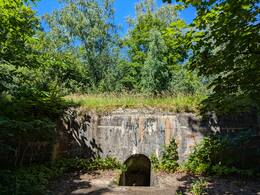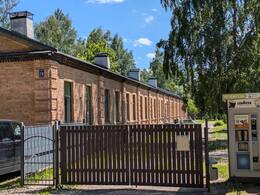ledi Ketlina
Kas atsitiko ledi Ketlinai?
Laivas yra Norvegijos krovininis laivas „Lady Kathleen“, kurį 1941 m. pastatė W & C French, Niuportas, JK. Ji buvo registruota Pål Wilson iš Bergeno, Norvegijoje. Jokių ryšių su Švedija, kiek matau.
Įgulą sudarė 16 vyrų ir radijo operatorė Kari Herje. Jie buvo išsiųsti namo lėktuvu per Leningradą, Helsingforsą, Stokholmą, kol jie 1951 m. gruodžio 5 d. atvyko į Fornebu oro uostą Osle, Norvegijoje.
Laivas su balastu atplaukė iš Helsinkio (Suomija) ir stovėjo inkare lapkričio 29 d. naktį, laukdamas druskos pakrovimo Rygoje, užklupus audrai. Sugedo inkarai ir ji buvo stipriai paplūdusi. Evakavus įgulą, korpusas subyrėjo gruodžio 1 d., o gelbėjimo darbai buvo palikti.
Norvegijos avarijos ataskaitoje apie alkoholį neužsimenama.
Jos sesuo, ledi Wollmer, nuskendo 1953 m., kai nusileido prie Qualpart salos Korėjoje.
https://militaryheritagetourism.info/lv/military/stories/view/4 dar viena laivo istorijos versija
Susijusios vietos
Mangalsalos įtvirtinimai
Pakrantės įtvirtinimai yra Rygoje, Mangaļsaloje, Dauguvos žiotyse, priešais Dauguvgryvą. Čia galima pamatyti įvairių kariuomenių (rusų, latvių, vokiečių ir sovietų) pastatytus įtvirtinimus. Mangalsalos įtvirtinimai buvo pastatyti siekiant apginti Rygos miestą nuo priešiškų laivynų. Ši sritis ilgą laiką buvo strategiškai svarbi. Po Pirmojo pasaulinio karo Latvijos kariuomenė dar neturėjo stipraus laivyno. Jūros siena buvo ilga, o pakrančių gynyba tapo vis sunkesnė užduotis. XIX amžiaus pabaigoje – XX amžiaus pradžioje Latvijos kariuomenė perėmė Rusijos imperijos statytus įtvirtinimus ir išplėtė gynybos sistemą. Dauguvos ir Mangalsalos artilerija atidengtų ugnį į priešo laivus, bandančius įplaukti į Dauguvos žiotis, o atramos taškai prie Lielupės (Jūrmala) ir Gaujos (Carnikava) žiočių sustabdytų priešo desantininkus. Taip pat buvo specialiai įrengtas šarvuotas pakrančių gynybos traukinys, galintis teikti artilerijos ugnį ir paramą Saulkrastų ar Jūrmalos kryptimis. Strateginių objektų įtvirtinimo tikslas buvo maksimaliai panaudoti ginklus per specialias konstrukcijas ir reljefo pranašumus. Pakrantės gynybos įtvirtinimai buvo išskirstyti didelėje teritorijoje, kad karo atveju atremtų priešo pastangas.
Garso vadovas https://izi.travel/en/edbf-mangalsala-fortifications/en
Fortifications of the Daugava River Mouth
The fortifications of the Daugava River mouth are the oldest structures on Mangaļsala. Here you can see the entire 400-year history of the island's military heritage, as well as examples of military architecture from several periods - the Swedish era, the Tsarist era, the era of free Latvia and the Second World War. The first gun positions on ancient maps in this area appear as early as the 17th century with the construction of the Daugavgrīva fortress, but later the fortifications were gradually expanded and renovated. During the Swedish era, dolomite was transported here by barges along the Daugava from the Koknese quarries for the construction of tunnels and gun positions. In the mid-19th century, piers began to be built in the Daugava. About twenty or thirty years later, red brick bunkers began to be built here. Two of the reinforced concrete gun positions were built already during the period of the Independent State of Latvia - in 1934, as evidenced by the engraving made with a finger or a branch in the concrete. Moving east, you can see anti-aircraft gun positions built by German troops during World War II. This is the only place on Mangalsala where real hostilities took place – during the Crimean War in the mid-19th century, the British fleet attacked Riga, but thanks to the fortifications of the Daugava estuary, the attack was not very successful. Half a century later – on July 2, 1919 – during the Latvian War of Independence, Estonian gunboats from the coast successfully fired on the positions of the German Iron Division on Mangalsala. During World War I, the fortifications of Daugavgrīva were so formidable that Riga was the only city on the Baltic coast that the German fleet avoided launching hostilities against. So, these Daugavgrīva fortifications have protected the port gates for centuries, preventing the enemy from entering Riga.
Attention! To protect hibernating bats (all species are protected), do not move underground and inside bunkers from October to April.
Remnants of training torpedoes
According to eyewitness accounts, the Soviet army stored ammunition on Mangalsala very carelessly, which could have been the cause of man-made disasters. Ammunition had been stored in this area since the time of Tsarist Russia – in both closed and open-type storage facilities. During the Soviet era, ammunition and naval mine warehouses of the USSR Baltic Fleet were located here. There was supposedly a torpedo workshop in Daugavgrīva.
“In Mangaļi, Riga District, where our mine and torpedo warehouse was located, 400 thousand tons of explosives were stored. (…) In addition, the warehouse stored hundreds of torpedoes, sea mines, fuse-detonated explosive charges and all sorts of other explosive junk. There was also a charge deactivation workshop. And a whole pile of small arms – from SKS carbines to “Parabellum” pistols,” writes former officer – Captain 2nd Rank Andrejs Riskins.
Nowadays, the "torpedoes" seen in the forest are training torpedo hulls cast in concrete.
Eastern (Mangalsala) Pier
Both piers on the Daugava are closely connected with military events and history. They were built at the end of the 19th century to reduce the clogging of the river mouth and regulate the flow, thereby ensuring shipping and at the same time - the protection of the Daugava mouth. Their strategic importance was associated with the protection of Riga as an important port and military base.
During World War I and the Latvian War of Independence, the area around the mouth of the Daugava River was a zone of military operations. During World War II, the piers were of great strategic importance, as they helped control the approach to Riga from the sea.
The pier is based on a wooden pile structure covered with stones. The pier is approximately one kilometer long.
Although today the Daugava piers are mainly used as a walking area and a historical site, their historical connection to military strategy and the protection of sea routes is an important aspect of Latvian history.
Caution! The surface of the pier can be slippery. Visiting it during strong winds and storms is dangerous!
Railway branch and platform
Around 1958, a special railway branch was built on Mangaļsala from the Vecāķi station for the needs of the Soviet army. It was the most convenient way to bring fuel, ammunition, firearms and building materials to the military base located here. Even earlier, starting from the 20th century and up to the Soviet years, a narrow-gauge railway ran through the entire Mangaļsala, transporting ammunition to the gun emplacements. Later, a more serious railway branch was built, crossing the Vecdaugava over one of the two – the least known – dams on Mangaļsala. For example, it is no longer possible to access this dam from the Vecāķi side, because the view is blocked by private property. The concrete hillock visible in nature was a platform. When Soviet troops left Latvia in the early 1990s, 600 wagons with approximately 30 tons of ammunition were transported along this railway. It is said that at that time it was done in such a hurry and so carelessly that "the whole of Riga could have been seen in the air". Or at least a certain Riga neighborhood. Shortly afterwards, the railway was dismantled.
Closed ammunition depots built in the 1950s
In the 1950s, such a bunker was built and covered with earth so that a potential enemy could not find it so easily. There are four such buildings in Mangalsala in total, all of which were built between 1953 and 1955. During the Soviet era, ammunition was stored here - underwater mines, torpedoes, etc. Currently, this is the cleanest of the closed-type ammunition depots from the Soviet era, but if you go further, you can also see the largest one.
Attention! To protect hibernating bats (all species are protected), do not move underground and inside bunkers from October to April.
Open ammunition depots, lightning conductors, wells
During the Soviet era, so much ammunition and military equipment was brought to Mangaļsala that there was not enough space in the warehouses, so a large part of it had to be stored in the open air. Only such things that could be damaged by moisture were placed in the premises. This action also shows the careless attitude of the Soviet army towards any kind of inventory: a sandbank was built around it, of which a small hillock still remains, but the bank itself protected the ammunition from fires and explosions. If a rocket were to explode in the vicinity here, the blast wave would hit the bank and would not reach further, or would reach a much smaller extent. Nearby is a reinforced concrete pole - a lightning rod! Such poles allowed to protect ammunition from lightning strikes. Similar poles can be observed in other places. Former water wells are also visible, so that if necessary, something could be extinguished. In general, information about the Mangalsala ammunition depots was very secret - even on old Soviet military maps these places are marked as pioneer camps. Approximately 50 meters behind the embankment is another concrete bunker.
Projectile warehouses
This building was built between 1876 and 1885, when Tsar Alexander II and after him Tsar Alexander III ruled here. It is worth paying attention to the facade of the building with cornices and window openings, etc. decorative forms. This building was used as a warehouse where cannon shells were stored. Approximately 300 meters from here there is another such warehouse, which even has beautiful, curved window grilles. Similar red brick military buildings can still be found here and there in Latvia - for example, in Liepāja Karosta. All the red brick buildings on the territory of Mangaļsala were built at about the same time. At that time, the political situation in Europe was complicated, and the Russian Empire began to militarily strengthen its Western border. The building has a double outer wall and air circulates between the walls, which not only creates additional ventilation, ensuring the necessary temperature and humidity level in the building, but is also able to cushion the explosion. In the event of a large explosion, the outer wall collapses, but the inner one remains intact, protecting what is inside the building. On top of the bunkers on the other side of Mangaļsalas Street, there were mortar positions. During the time of free Latvia – in 1926 – anti-aircraft guns, or cannons that move on wheels, were placed instead of mortars! Not far from here is one of the thickest pine trees in Riga. Moreover, it is not only thick and large, but also wounded – bullet marks can be found on the pine trunk. In what battles the pine suffered – it is unknown!
Attention! To protect hibernating bats (all species are protected), do not move underground and inside bunkers from October to April.
Chemical warehouse and bypass road
This bunker was built in 1955 - during the Soviet occupation. The path around this building was once a bypass road, surrounded by a double barbed wire fence. Guards walked behind it and watched to see if any unauthorized person approached the facility. This building is mentioned in some sources as an ammunition depot, and in others - a chemical storage facility. It is said that there were even nuclear missiles here, but no traces of radiation have been found here. It is completely dark inside, but then - light is visible. It used to be a ventilation system. This is the only building on Mangalsala that had ventilation. Cargo was brought here by wagons along the railway. The acoustics are very good - once a youth choir even had a rehearsal here! However, here and there, graffiti art works are placed on the walls of the building.
Attention! To protect hibernating bats (all species are protected), do not move underground and inside bunkers from October to April.
Latvian Army Spotlight Point
The peculiar horseshoe-shaped concrete structure was once the location of a searchlight. Meanwhile, a hundred meters further towards Vecāķi, a searchlight helmsman sat in a small concrete bunker and watched for any unauthorized person approaching from the coastal side. There were practically no trees here, so the entire area was clearly visible. If an attacker started shooting at the light source, the helmsman would be completely protected – submerged in the cover of darkness and concrete. This searchlight point was built by the Latvian army in 1928, continuing to adapt the already militarized Mangaļsala to its needs. Later, during the Soviet occupation, the searchlight could also be used to watch for anyone intending to go in the opposite direction and flee to the “wild west”. Leaving the country without permission was prohibited. In addition to security, the coastal sand was also plowed up so that the tracks of illegal immigrants or pedestrians could be seen.
Coastal artillery battery
This is the largest military structure on Mangalsala, which began to be built between 1912 and 1916. The walls of the bunker were several meters thick, and it was protected from the sea by a sandbank. During the First World War, the German fleet did not come to Riga, only thanks to the cannons stationed here. In 1917, the Russians withdrew from Riga on their own and blew up part of the bunker when they left. During the Latvian Independence period – in the 1930s – and later during the Soviet years, this battery was renovated and expanded – the cannon platforms were rebuilt and new cannons were installed. In 1941 – during the Second World War, the Russians blew up this battery again, fearing that German troops might enter Latvia. The first cannons fired approximately 12 to 15 kilometers, but the newer ones could hit the target at a distance of up to 40 kilometers. There is an inscription: “Built by sailors” - built by sailors in 1946. In the basement of the bunker there were ammunition cellars, where the shells needed for the guns were stored. There were special hatches in the walls through which shells could be fed for faster loading of the guns in combat conditions. Now here is the longest military tunnel on Mangalsala - a corridor about 100 meters long. In the spring, part of the bunker tends to flood! In the 1960s, aviation technology developed, missiles and air defense systems were invented, and this battery with all its guns - once so scary and powerful - became unnecessary to anyone.
Attention! To protect hibernating bats (all species are protected), do not move underground and inside bunkers from October to April.
Army town
In this area, in the late 1920s and early 1930s, the Latvian army built an army camp for officers and soldiers who worked on Mangalsala. Later, the camp, along with the Mangalsala military base, became the property of the Soviet Union. Civilians without a certain status lived here, but later social apartments were created for low-income people. On the right side there was a football field and small gardens, but over time they turned into meadows and swamps. Later, private houses and a car service appeared here. Until the 1960s, Mangalsala was not part of Riga at all, but part of Mangali parish. At that time, people here were engaged in fishing or worked at the army base, because agriculture was practically impossible – the arable land area on Mangalsala is only 3.8%. Once upon a time, a narrow-gauge railway ran through the camp right along Mangalsala Street, but the street itself was paved. Now the pavement is hidden under a layer of asphalt. At the end of the road is the port area and the former military pier. Army ships were once moored there, and footbridges were built between them.
Can be seen from the outside, walking along Mangaļsalas Street.
Riga Garrison Army Tent Camp
Now there are bushes and thickets here, but in the thirties of the last century, the Riga garrison army summer camp was located here. In some places you can still see what look like rectangular ramparts. In these places there were soldiers' tents, arranged in four long rows, with small streets in the middle. At the ends of the rows stood the logos of the garrison units - they were cast from concrete, but the ornaments and inscriptions were made of small, colorful stones. The ramparts around the tents were necessary not only to retain moisture, but also for military purposes. If landing troops entered Mangaļsala, they would be used as trenches under the cover of which to protect the territory from the enemy. Although real military training was taking place here, a romantic idyll reigned in the air, which is also visible in photographs of the time. Young people played volleyball. In the courtyards of the officers' cottages, gazebos and flower beds were well-groomed. The soldiers were visited by their loved ones on weekends, bringing baskets of strawberries and fresh bread. Most meals were eaten outside at tables in the fresh air.




